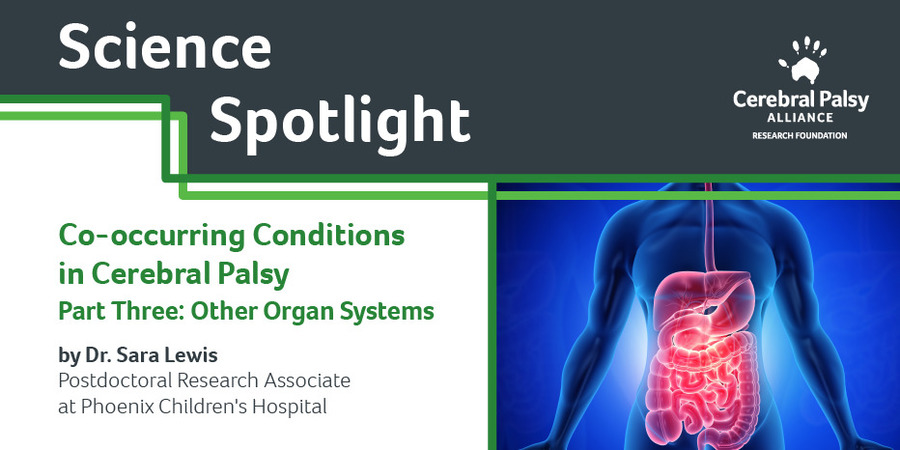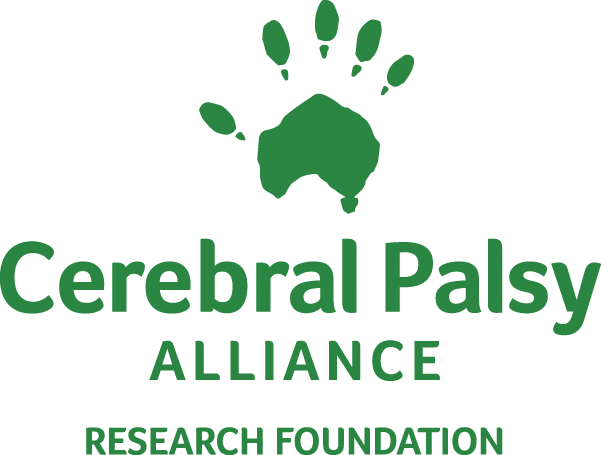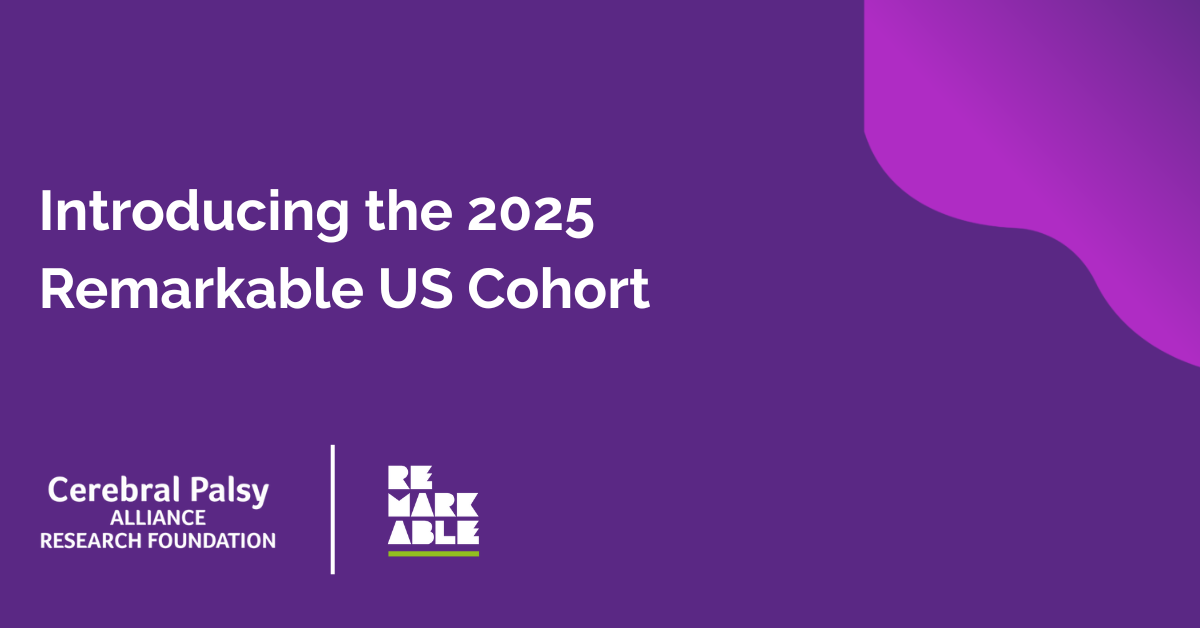
Science Spotlight: Co-occurring Conditions in Cerebral Palsy
Part Three: Other Organ Systems
By Dr. Sara Lewis
Want to catch up on this series? Check out the first part of this series on co-occurring features of cerebral palsy (CP) focusing on changes in the developing brain and the second part on muscle and skeletal changes.
Along with everything discussed in earlier posts, there are several unexpected features that can appear with CP. One possible explanation is that there are some genes that can cause CP, and those genes are expressed in many places. Therefore, issues with the gene may alter the development of the brain, as well as other parts of the body. Another explanation is that changes in connections between the brain and the body can change the way our smooth muscles regulate organ function, such as gut motility or bladder control. Finally, other developmental changes to the brain and body could contribute to someone’s risk of acquiring CP.
Congenital anomalies are structural or functional anomalies that occur during development and may be identified before or at birth, or later in life. Congenital anomalies include defects of the formation of organs or the structure of the head, hand, or foot, and they are present in 12 to 33% of people with CP (1.5 to 4 times the population without CP). Some also affect the brain, such as microcephaly that decreases brain size and hydrocephaly that increases the size of the fluid compartments of the brain. Problems with the circulatory system were the most common issues affecting other parts of the body, and issues can affect the heart, blood vessels, and blood. It’s possible that some of these conditions could contribute to acquiring CP.
Other congenital anomalies, such as those affecting the genitourinary or respiratory systems, suggest that a different type of cause, such as a genetic disorder, could be the cause for both.
Dental abnormalities are another potential issue. Malocclusion is when the teeth are not aligned properly, which includes underbite and overbite, and this occurs in between 59% and 92% of people with CP. This misalignment between the two sets of teeth can be caused by weakness or tension of the muscles of the mouth and jaw causing changes to the mouth structure. There is also an increased risk of periodontal disease and cavities in around 55% of people with CP.
At least one third of people with CP encounter gastrointestinal problems. These include feeding and swallowing disorders, regurgitation and vomiting, abdominal pain, and constipation. These issues contribute to malnutrition, which affects 23% of people with CP (20 times more common in this population). Gastrointestinal issues can contribute to growth impairments.
Additionally, endocrine, skin and subcutaneous tissue disease, immune, blood, and genital disorders can all be present.
Urologic conditions include neurogenic bladder, where the nerves connecting the bladder and brain are impaired, leading to difficulty with bladder sensing or control. Urologic conditions occurs in 30 to 60% of people with CP. Respiratory disease is present in 30% (2.3 times the population without CP). Neoplasms — excessive tissue growth — can present as either benign in 3.5% (1.4 times the population without CP) or malignant in 0.8% (4 times the population without CP). These diverse features could arise from changes to muscles, the brain, or may arise during development in parallel with the changes that contribute to cerebral palsy.
There is increased awareness that individuals with CP are more susceptible to acquiring adulthood disorders that can affect many different parts of the body. These numerous features are just one reason that no two people with CP will be alike while sharing similar challenges. Although CP is defined as a movement disorder, CP can be a much more challenging disability because of co-occurring changes to the body. If you want to read more, check out Part One and Part Two in this series.
About the Author: Dr. Sara Lewis is a Postdoctoral Research Associate at Phoenix Children’s Hospital working with Dr. Michael Kruer to identify genetic causes of cerebral palsy. She received her PhD in Neuroscience in 2015 with an emphasis in genetic neurodevelopmental disorders. Her work integrates human genetics with the fly model to study how genes leading to movement disorders changes in the brain. Her work also addresses the challenges implementing genetics findings in the clinical environment. Her research is funded by CPARF.
Articles Referenced:
Hollung SJ, Bakken IJ, Vik T, Lydersen S, Wiik R, Aaberg KM, Andersen GL. Comorbidities in cerebral palsy: a patient registry study. Dev Med Child Neurol. 2020 Jan;62(1):97-103. doi: 10.1111/dmcn.14307. Epub 2019 Jul 4. PMID: 31273772.
Graham HK, Rosenbaum P, Paneth N, Dan B, Lin JP, Damiano DL, Becher JG, Gaebler-Spira D, Colver A, Reddihough DS, Crompton KE, Lieber RL. Cerebral palsy. Nat Rev Dis Primers. 2016 Jan 7;2:15082. doi: 10.1038/nrdp.2015.82. PMID: 27188686; PMCID: PMC9619297.
Whitney DG, Schmidt M, Hurvitz EA. Shared Physiologic Pathways Among Comorbidities for Adults With Cerebral Palsy. Front Neurol. 2021 Oct 4;12:742179. doi: 10.3389/fneur.2021.742179. Erratum in: Front Neurol. 2022 Jan 18;12:830052. PMID: 34671312; PMCID: PMC8520916.
Mon 08 Sep 2025
We’re proud to share that CPARF’s 2025 Remarkable US Accelerator cohort kicks off this week! This program supports disability-focused startups that are developing cutting-edge assistive technology. Remarkable US brings life-changing ideas to market faster and ensures people with disabilities can access affordable new technology as soon as possible. Meet the 2025 Cohort: The […]
Wed 21 May 2025
Are you ready for STEPtember 2025? We’re officially in double digits — CPARF is celebrating 10 years of funding groundbreaking cerebral palsy research and driving innovation forward. And there’s no better way to mark this milestone than with our biggest, boldest STEPtember yet. Thanks to you, STEPtember has grown into a global movement that powers […]




